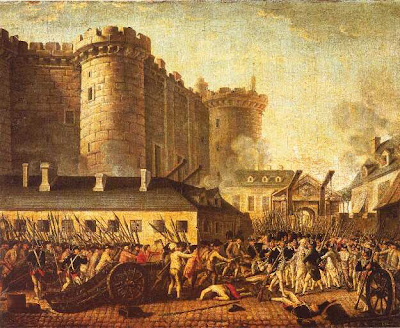La Prise de la Bastille
 |
The storming of the Bastille prison on July 14th, 1784
The Apocalypse of the French Revolution. |
The Bastille
The Bastille was a fortress-prison in Paris, known formally as Bastille Saint-Antoine—Number 232, Rue Saint-Antoine—best known today because of the storming of the Bastille on 14 July 1789, which along with the Tennis Court Oath is considered the beginning of the French Revolution. The event was commemorated one year later by the Fête de la Fédération. The French national holiday, celebrated annually on 14 July is officially the Fête Nationale, and officially commemorates the Fête de la Fédération, but it is commonly known in English as Bastille Day. Bastille is a French word meaning "castle" or "stronghold", or "bastion"; used with a definite article (la Bastille in French, the Bastille in English), it refers to the prison.
The Storming of Bastille and the French Revolution
The confrontation that led to the people of Paris storming the Bastille on 14 July 1789, following several days of disturbances, resulted from the fact that gunpowder and arms had been stored there, and the people (whose fears had been raised by a number of rumors) demanded access to these. The later idea that they wanted to free the prisoners (only 7 of whom remained) has been
discounted. The regular garrison consisted of 82 invalides (veteran soldiers no longer capable of service in the field) under Governor Bernard-René de Launay. They had however been reinforced by a detachment of 32 grenadiers from one of the Swiss mercenary regiments summoned to Paris by the King shortly before 14 July.
 |
| The Bastille prison, after storming |
A crowd of around 8800 men and women gathered outside around mid-morning, calling for the surrender of the prison, the removal of the guns and the release of the arms and gunpowder. Two people chosen to represent those gathered were invited into the fortress and slow negotiations began.
In the early afternoon around 1:00, the crowd broke into the undefended outer courtyard and the chains on the
drawbridge to the inner courtyard were cut. A spasmodic exchange of gunfire began; in mid-afternoon the crowd was reinforced by
mutinous Gardes Françaises of the Royal Army, and two cannons, all of which were originally supposed to help the governor protect the prison. De Launay ordered a ceasefire; in spite of his surrender demands being refused, he capitulated and the
vainqueurs swept in to take control of the fortress at around 5:30.
When the rioters entered the Bastille, they collected cartridges and gunpowder for their weapons and then freed the seven prisoners (which they had to do by breaking down the doors, since the keys had already been taken off and paraded through the streets). Later, the governor and some of the guards of the Bastille were murdered under chaotic circumstances, despite having surrendered under a flag of truce, and their heads paraded on pikes.
The Bastille Day
 |
| Military March on Bastille Day |
Bastille Day is
the French national holiday which is celebrated on 14 July each year. In France, it is formally called La Fête Nationale (The National Celebration) and commonly
le quatorze juillet (
the fourteenth of July). It commemorates the
1790 Fête de la Fédération, held on the first anniversary of the storming of the Bastille on 14 July 1789; the anniversary of the storming of the Bastille fortress-prison was seen as a symbol of the uprising of the modern nation, and of the reconciliation of all the French inside the constitutional monarchy which preceded the First Republic, during the French Revolution. Festivities are held on the morning of 14 July, on the Champs-Élysées avenue in Paris in front of the President of the Republic.
From Wikipedia, the Free Encyclopedia
 privte ownership
privte ownership




